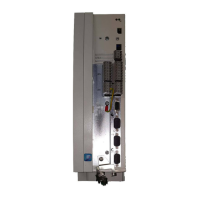Basics for wiring according to EMC
Installation in the control cabinet
5.3
5.3.5
5.3−4
EDSVF9383V EN 7.1−04/2012
5.3.5 Installation in the control cabinet
ƒ Only use mounting plates with conductive surfaces (zinc−coated or
V2A−steel).
ƒ Painted mounting plates are not suitable even if the paint is removed
from the contact surfaces.
ƒ If several mounting plates are used, ensure a large−surface connection
between the mounting plates (e.g. by using earthing strips).
ƒ Connect the controller and the chokes to the grounded mounting plate
with a surface as large as possible.
ƒ The motor cable is optimally installed if
– it is separated from mains cables and control cables,
– it crosses mains cables and control cables at right angles.
ƒ Always install cables close to the mounting plate (reference potential),
as freely suspended cables act like aerials.
ƒ Lead the cables to the terminals in a straight line (avoid tangles of
cables).
ƒ Use separated cable channels for motor cables and control cables. Do
not mix up different cable types in one cable channel.
ƒ Minimise coupling capacities and coupling inductances by avoiding
unnecessary cable lengths and reserve loops.
ƒ Short−circuit unused cores to the reference potential.
ƒ Install the positive and negative wires for DC 24 V close to each other
over the entire length to avoid loops.
ƒ Connect all components (controller, chokes) to a central earthing point
(PE rail).
ƒ Set up a star−shape earthing system.
ƒ Comply with the corresponding minimum cable cross−sections.
Mounting plate requirements
Mounting of the components
Optimum cable routing
Earth connections

